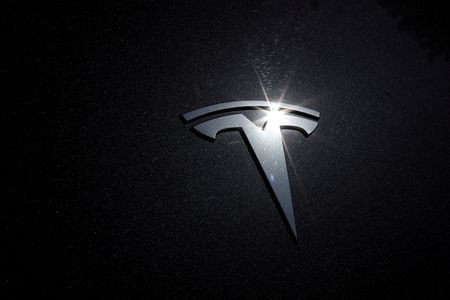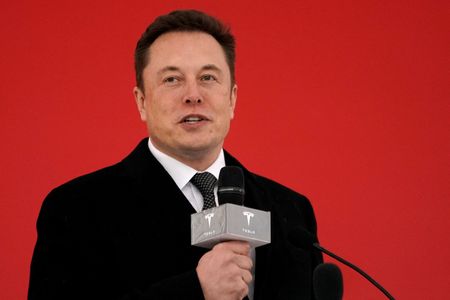

By Hyunjoo Jin and Nivedita Balu
SAN FRANCISCO (Reuters) – Tesla Inc on Wednesday forecast annual deliveries would comfortably grow by more than 50% year-over-year in 2022 despite supply chain issues that it said would continue through this year and limit electric vehicle production.
The upbeat outlook from CEO Elon Musk sent shares up 1.6% after hours and came after the world’s most valuable automaker posted record quarterly revenue that beat Wall Street expectations.
But the cautious note about supply chain woes showed that even Tesla cannot avoid the shortages that were pitfalls for many larger automakers last year. And Tesla has the additional challenge of opening two new factories this year with chips and other parts in short supply and new batteries and technologies to be introduced.
Musk said that Tesla would not introduce new models this year, but hopefully would launch its Cybertruck, Semi and Roadster next year.
Revenue rose to $17.72 billion in the fourth quarter, from $10.74 billion a year earlier. Analysts had expected the electric-vehicle maker to report revenue of $16.57 billion, according to IBES data from Refinitiv.
Tesla has fared better than most automakers in managing supply chain issues by using less scarce chips and quickly re-writing software. The automaker last quarter handed over a record number of vehicles to customers despite supply chain headwinds.
“Our own factories have been running below capacity for several quarters as supply chain became the main limiting factor, which is likely to continue through 2022,” Tesla said in a statement.
Tesla said on Wednesday that its new factory in Austin has started production of Model Y late last year, adding it plans to start deliveries to customers soon after final certification.
It said it aims to maximize output from its California factory beyond 600,000 vehicles per year.
“The pace of production ramps in Austin and Berlin will be influenced by the successful introduction of many new product and manufacturing technologies in new locations, ongoing supply-chain related challenges and regional permitting,” Tesla said.
It faces rising competition from rivals who are set to launch an array of electric cars, from more affordable models to electric pickups.
Musk said he expected Tesla’s vehicles to achieve full self-driving capability this year. Currently humans are required to sit behind the wheel to drive the car if needed.
The number of full self-driving beta vehicles in the United States increased to nearly 60,000, up from a few thousand at the end of September. Tesla has been testing the improved version of its automated driving software on public roads, but it has said the features do not make the cars autonomous.
Tesla’s $4.09 billion in adjusted earnings before interest, tax, depreciation and amortization (EBITDA) beat the consensus estimate of $3.89 billion, according to Refinitiv. That appeared to qualify Musk for an additional options payout under his 2018 compensation package.
Quarterly profits took a $340 million hit from payroll taxes related to Musk exercising options related to his 2012 compensation package.
The profits also reflected rising raw material, commodity and logistics costs and expenses related to warranties and recalls. Tesla is recalling more than 475,000 of its Model 3 and Model S electric cars to address rearview camera and trunk issues that increase the risk of crashing.
(Reporting by Hyunjoo Jin in San Francisco and Nivedita Balu and Akash Sriram in Bengaluru; Editing by Lisa Shumaker and Peter Henderson)

